In the News:
The pace of natural gas drilling in Pennsylvania is slowing, according to data from the Pennsylvania Department of Environmental Protection (DEP).
Through the first seven months of 2012, operators started drilling an average of 4.6 natural gas wells per day; in contrast, natural gas well starts averaged over 6 per day in both 2010 and 2011.
DEP reports that the number of natural gas wells started per month in 2012 remained fairly steady through April, but has since declined sharply. This holds particularly true for horizontal wells, which in Pennsylvania have significantly outnumbered non-horizontal (vertical) wells since 2010. Horizontal wells have been drilled primarily in sections of the Marcellus, Utica, and Geneseo/Burket shale formations located in the northeast and southwest portions of the state. On average, 5 horizontal natural gas wells were started each day in 2011. In 2012, the new horizontal well count generally remained above 4 per day through April, but has fallen steadily thereafter. In July 2012, operators began drilling, on average, only 2.5 horizontal natural gas wells each day.
Among the factors influencing Pennsylvania's natural gas drilling activity in 2012 are low regional natural gas prices, an abundant inventory of already drilled but not yet producing natural gas wells, and constrained transportation facilities.
Overview:
(For the Week Ending Wednesday, August 22, 2012)
- Natural gas prices generally registered moderate overall decreases for the report week (Wednesday to Wednesday) at many of the country's trading locations. The Henry Hub price, which had dropped 12 cents per million British thermal units (MMBtu) by Friday, rose on Monday and Tuesday, closing at $2.80 per MMBtu yesterday (down 2 cents per MMBtu for the week).
- The natural gas futures market trended downward over the first part of the week before rebounding strongly. At the New York Mercantile Exchange (NYMEX), the September 2012 natural gas contract gained 7.8 cents per MMBtu to close at $2.826 per MMBtu yesterday.
- Working natural gas in storage rose last week to 3,308 billion cubic feet (Bcf) as of Friday, August 17, according to the U.S. Energy Information Administration's (EIA) Weekly Natural Gas Storage Report (WNGSR). An implied storage build of 47 Bcf for the week positioned storage volumes 423 Bcf above year-ago levels.
- The natural gas rotary rig count, as reported by Baker Hughes Incorporated on August 17, declined by 11 to 484 active units. Meanwhile, oil-directed rigs dropped by 7 to 1,425 units.
Prices:
The Henry Hub day-ahead price registered a modest decrease for the week, dipping on Thursday and Friday before regaining ground on Monday and Tuesday, closing the week at $2.80 per MMBtu, down 0.7 percent. In the Northeast, cooler temperatures helped generate price decreases earlier this week, with a return to somewhat warmer temperatures boosting end-of-week prices in certain locations.
At the NYMEX, the September 2012 contract ended the week with a net gain, rising from $2.748 per MMBtu last Wednesday to $2.826 per MMBtu yesterday, an increase of 7.8 cents per MMBtu. Prices dropped late last week, falling to $2.719 per MMBtu on Friday, but rose steadily thereafter to finish the week up 2.8 percent. The 12-Month Strip (average of September 2012 to August 2013 contracts) closed yesterday at $3.316 per MMBtu, up 3.3 cents per MMBtu (1.0 percent) for the week.
Prices at many downstream trading locations registered overall declines, dropping on Thursday and Friday before gaining ground toward the end of the week. For example, spot prices at the Transcontinental Pipeline's Zone 6 trading point (which serves New York City markets) declined from $2.98 per MMBtu last Wednesday to $2.77 per MMBtu on Friday, then climbed to $2.88 per MMBtu by week's end (down 3.4 percent). At the Algonquin Citygate trading point for delivery into Boston, prices fell especially sharply, starting the week at $3.81 per MMBtu, falling to $2.97 per MMBtu on Tuesday, and then rising slightly, closing yesterday at $2.98 per MMBtu (down 21.8 percent for the week).
Total consumption for the report week registered an overall decrease, with lower power sector demand offsetting increases in residential/commercial and industrial sector demand. According to estimates from BENTEK Energy LLC (Bentek), domestic natural gas consumption declined by 5.1 percent from last week, driven by an 11.0 percent decrease in power sector consumption. Residential/commercial sector consumption finished the week up 4.5 percent, while industrial sector consumption rose relatively modestly (0.7 percent). Although down week-over-week, power sector consumption exceeded levels for the same week last year by 2.3 percent.
Total supply for the week was essentially unchanged, registering an overall increase of 0.2 percent, reflecting relatively flat dry gas production. According to Bentek estimates, domestic weekly dry gas production rose 0.8 percent higher over the previous week's volumes (and was 3.4 percent higher than the same period last year). Imports from Canada fell by 5.8 percent, as declines in shipments to the Northeast and Midwest offset a small increase in the West. For the week, imports from Canada stand close to year-ago volumes (up 0.5 percent). While liquefied natural gas (LNG) sendout rose 4.8 percent over last week, sendout volumes remain well below (36.7 percent) year-ago levels.
Storage
Working natural gas in storage increased to 3,308 Bcf as of Friday, August 17, according to EIA's WNGSR. This represents an implied net injection of 47 Bcf from the previous week. This week's injection was 6 Bcf below the 5-year (2007-2011) average injection of 53 Bcf, and 19 Bcf below last year's injection of 66 Bcf. Since April 27, injections of working natural gas into underground storage have fallen short of both year-ago levels and the 5-year average, although stocks remain well above historical levels. Inventories are currently 423 Bcf (14.7 percent) greater than last year at this time and 357 Bcf (12.1 percent) greater than the 5-year average.
Two of the three storage regions posted an increase this week. Inventories in the East and Producing regions increased by 48 Bcf (the 5-year average net injection is 51 Bcf) and 4 Bcf (the 5-year average change is 0 Bcf), respectively. The West region posted a decrease of 5 Bcf (the 5-year average net injection is 3 Bcf). In the Producing Region, working natural gas inventories decreased 2 Bcf (0.9 percent) in salt cavern facilities and increased 7 Bcf (0.8 percent) in nonsalt cavern facilities.
Temperatures during the storage report week were 0.7 degrees warmer than the 30-year normal temperature and 0.9 degrees warmer than the same period last year. Temperatures in the lower 48 States averaged 75.1 degrees, compared to 74.3 last year and the 30-year normal of 74.4. While overall temperatures were about a degree warmer than normal, temperatures varied somewhat across Census Divisions. The Pacific Census division in the West was particularly warm, averaging 7.0 degrees warmer than the 30-year normal. In the Midwest, temperatures in the West North Central and East North Central Census divisions were cool, averaging 4.0 and 3.9 degrees cooler, respectively, than the 30-year normal.
See also:
Daily natural gas well starts in Pennsylvania
wells startedhorizontal share
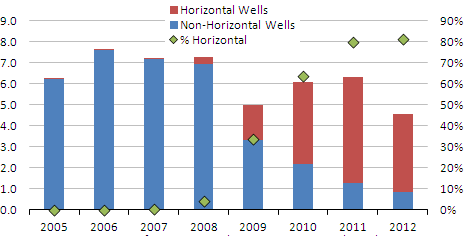
Source: PA Department of Environmental Protection; 2012 is through July.
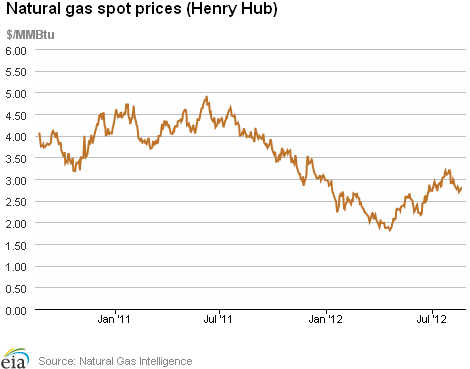
| Spot Prices ($/MMBtu) | Thu, 16-Aug |
Fri, 17-Aug |
Mon, 20-Aug |
Tue, 21-Aug |
Wed, 22-Aug |
|---|---|---|---|---|---|
| Henry Hub | 2.78 |
2.70 |
2.75 |
2.80 |
2.80 |
| New York | 2.94 |
2.77 |
2.83 |
2.86 |
2.88 |
| Chicago | 2.85 |
2.75 |
2.82 |
2.87 |
2.86 |
| Cal. Comp. Avg,* | 2.90 |
2.79 |
2.87 |
2.88 |
2.91 |
| Futures ($/MMBtu) | |||||
| September Contract | 2.724 |
2.719 |
2.776 |
2.775 |
2.826 |
| October Contract | 2.767 |
2.764 |
2.815 |
2.809 |
2.863 |
| *Avg. of NGI's reported prices for: Malin, PG&E citygate, and Southern California Border Avg. | |||||
| Source: NGI's Daily Gas Price Index | |||||
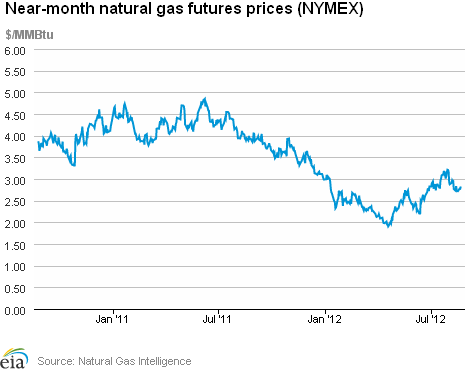
| U.S. Natural Gas Supply - Gas Week: (8/15/12 - 8/22/12) | ||
|---|---|---|
Percent change for week compared with: |
||
last year |
last week |
|
| Gross Production | 3.35%
|
0.79%
|
| Dry Production | 3.37%
|
0.79%
|
| Canadian Imports | 0.50%
|
-5.84%
|
| West (Net) | 26.58%
|
0.18%
|
| MidWest (Net) | -20.57%
|
-4.25%
|
| Northeast (Net) | -7.28%
|
-29.39%
|
| LNG Imports | -36.71%
|
4.85%
|
| Total Supply | 2.92%
|
0.24%
|
| Source: BENTEK Energy LLC | ||
| U.S. Consumption - Gas Week: (8/15/12 - 8/22/12) | ||
|---|---|---|
Percent change for week compared with: |
||
last year |
last week |
|
| U.S. Consumption | 4.19%
|
-5.14%
|
| Power | 2.28%
|
-11.05%
|
| Industrial | 2.93%
|
0.68%
|
| Residential/Commercial | 12.51%
|
4.46%
|
| Total Demand | 5.06%
|
-5.15%
|
| Source: BENTEK Energy LLC | ||
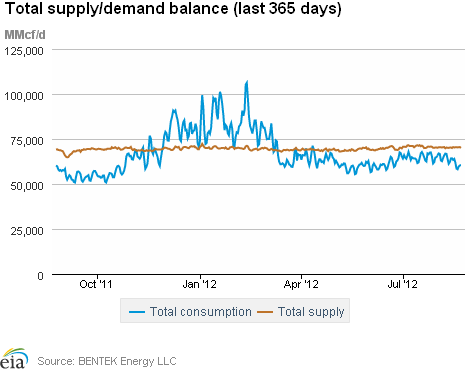
Weekly natural gas rig count and spot Henry Hub
active rigs$ per MMBtu
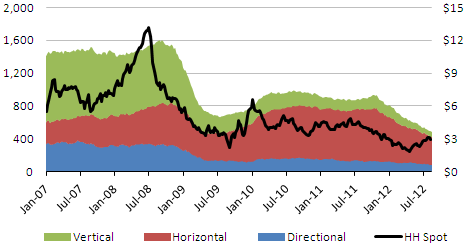
Source: Baker Hughes
| Rigs | |||
|---|---|---|---|
Fri, August 17, 2012 |
Change from |
||
last week |
last year |
||
| Oil Rigs | 1,425 |
-0.49% |
33.68% |
| Natural Gas Rigs | 484 |
-2.22% |
-46.22% |
| Miscellaneous | 5 |
25.00% |
-37.50% |
| Rig Numbers by Type | |||
|---|---|---|---|
Fri, August 17, 2012 |
Change from |
||
last week |
last year |
||
| Vertical | 532 |
-2.03% |
-12.64% |
| Horizontal | 1,153 |
-0.69% |
1.32% |
| Directional | 229 |
0.88% |
0.88% |
| Source: Baker Hughes Inc. | |||
| Working Gas in Underground Storage | ||||
|---|---|---|---|---|
Stocks billion cubic feet (bcf) |
||||
| Region | 8/17/12
|
8/10/12
|
change |
|
| East | 1,712 |
1,664 |
48
|
|
| West | 488 |
493 |
-5
|
|
| Producing | 1,108 |
1,104 |
4
|
|
| Total | 3,308 |
3,261 |
47
|
|
| Source: U.S. Energy Information Administration | ||||
| Working Gas in Underground Storage | |||||
|---|---|---|---|---|---|
Historical Comparisons |
|||||
Year ago (8/17/11) |
5-year average (2007-2011) |
||||
| Region | Stocks (Bcf) |
% change |
Stocks (Bcf) |
% change |
|
| East | 1,507 |
13.6 |
1,597 |
7.2 |
|
| West | 420 |
16.2 |
425 |
14.8 |
|
| Producing | 958 |
15.7 |
930 |
19.1 |
|
| Total | 2,885 |
14.7 |
2,951 |
12.1 |
|
| Source: U.S. Energy Information Administration | |||||
| Temperature -- Heating & Cooling Degree Days (week ending Aug 16) | ||||||||
|---|---|---|---|---|---|---|---|---|
HDD deviation from: |
CDD deviation from: |
|||||||
| Region | HDD Current |
normal |
last year |
CDD Current |
normal |
last year |
||
| New England | 0
|
-3
|
-3
|
56
|
19
|
36
|
||
| Middle Atlantic | 0
|
-3
|
-2
|
57
|
6
|
18
|
||
| E N Central | 8
|
3
|
2
|
24
|
-24
|
-6
|
||
| W N Central | 8
|
4
|
6
|
38
|
-24
|
-12
|
||
| South Atlantic | 0
|
0
|
0
|
91
|
0
|
-5
|
||
| E S Central | 1
|
0
|
1
|
71
|
-17
|
-11
|
||
| W S Central | 0
|
0
|
0
|
136
|
13
|
-12
|
||
| Mountain | 2
|
-3
|
1
|
96
|
26
|
14
|
||
| Pacific | 0
|
-3
|
-2
|
91
|
46
|
46
|
||
| United States | 3
|
0
|
1
|
74
|
5
|
7
|
||
|
Note: HDD = heating degree-day; CDD = cooling degree-day Source: National Oceanic and Atmospheric Administration | ||||||||
Average temperature (°F)
7-Day Mean ending Aug 16, 2012
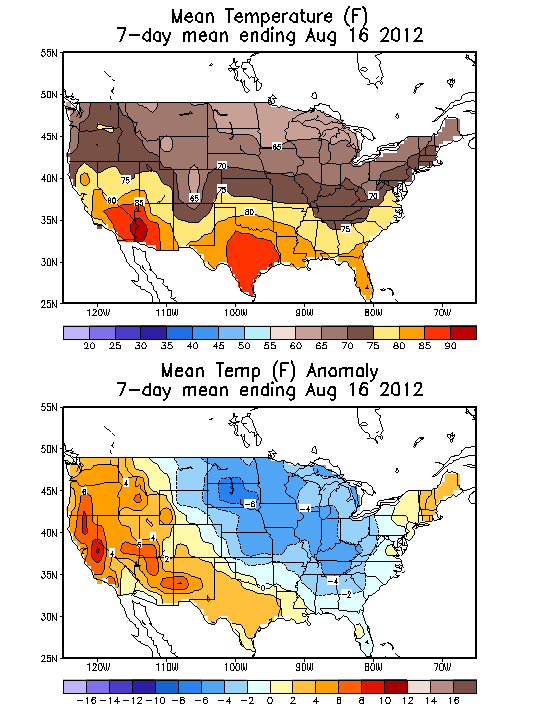
Source: NOAA/National Weather Service
Deviation between average and normal (°F)
7-Day Mean ending Aug 16, 2012

Source: NOAA/National Weather Service
Monthly dry shale gas production
billion cubic feet per day
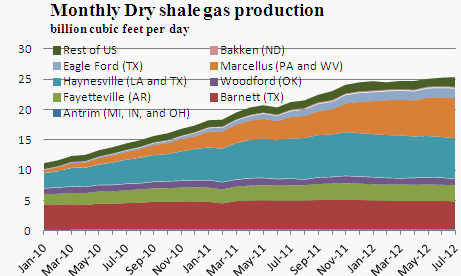
Source: Lippman Consulting, Inc. Gross withdrawal estimates are as of July 2012 and converted to dry production estimates with EIA-calculated average.
